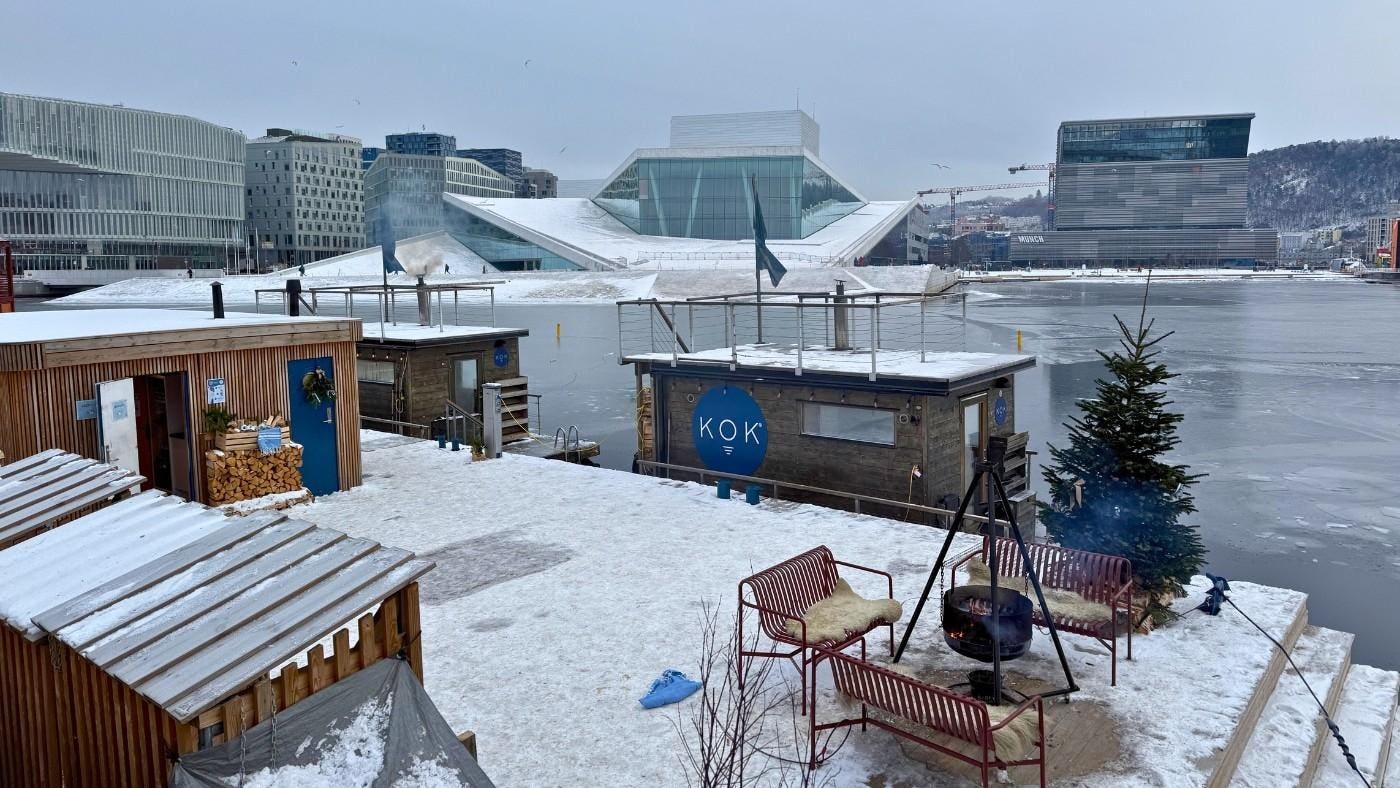Oslo offers several sauna and cold plunge facilities at the heart of the city.
David Nikel
Oslo’s waterfront has undergone one of Europe’s most remarkable urban transformations. What was once a working port has become a cultural showcase, home to the striking Munch Museum, the marble-and-glass Oslo Opera House and a growing list of restaurants, galleries and open public spaces.
The city has deliberately oriented itself toward the fjord, inviting residents and visitors to treat the shoreline as an extension of everyday life.
Yet look a little closer and you notice something else. Scattered along the waterfront are small architectural curiosities: sleek timber cabins, glass-fronted cubes and barrel-shaped huts, most tied to the quayside but others even floating gently out on the water.
They may look like art installations, but they are something much more integral to contemporary Nordic life. They are saunas. And more importantly, they are part of a fast-growing culture of cold-water swimming and heat therapy that is reshaping how Scandinavians unwind, socialize and stay well throughout the year.
What began in Finland as an ancient household tradition has, in the past decade, evolved into a distinctly modern, communal and design-forward experience across Norway.
In Oslo alone, it is now common to see groups of friends stepping straight from a wood-fired sauna into the winter fjord, laughing through the shock of the cold, then returning to the heat to repeat the cycle again.
This is no longer a niche wellness trend. It is becoming one of the defining travel experiences of contemporary Norway.
From Finland To The Norwegian Fjords
It’s not accurate to say that sauna and cold-water swimming are new to Scandinavia. Far from it. But there is little doubt about the cultural heartland of the tradition.
You are never far from a sauna facility in Finland.
getty
In Finland, sauna is not a wellness trend. It is everyday life. Saunas are found in homes, apartment buildings, offices and lakeside cottages.
For generations, the routine has been simple: heat, cold, rest, repeat. It is a rhythm that restores the body and clears the mind, especially during the long northern winter.
What has changed recently is how this tradition has been reinterpreted across the region. In Norway, a wave of new public and semi-public saunas have been built along urban waterfronts.
Many of them are floating, modular or architecturally expressive, designed to invite people to step directly from warm cedar interiors into cold sea water. The ritual has moved from the privacy of the home to the shared space of the city.
There are several reasons for this shift. Scandinavian cities have invested heavily in opening their waterfronts for public use, creating promenades, sea baths and harbor parks that encourage life outdoors in all seasons.
At the same time, interest in low-impact wellness and nature-based experiences has grown significantly. Travelers and locals alike are seeking ways to feel connected to place, to climate and to the body in a more immediate way.
Cold-water swimming also offers something that modern wellness trends often lack: simplicity. No equipment, no instruction, no performance. Just the straightforward sensation of being very warm, then very cold, then deeply calm. The result is a shared experience that feels both ancient and contemporary.
Where To Try A Fjord Sauna In Norway
Tromsø has become one of the most striking places to experience the sauna-and-sea ritual. The glass-fronted sauna at Pust sits on the harbor, surrounded by mountains and Arctic light.
Trondheim is home to several new fjord sauna facilities including Stu at Brattøra.
David Nikel
In winter, you can step out of the heat and plunge directly into the fjord beneath a sky filled with stars or, if you are lucky, the northern lights.
Oslo’s waterfront has become a living sauna district, with floating cabins tied up along the harbor. KOK operates a fleet of timber saunas you can rent privately, some docked and others that can be taken out onto the fjord. SALT, near the Opera House, takes a cultural approach with multiple saunas, food stalls and occasional music and art events.
Trondheim has burst on to the sauna scene too, thanks to the lively sauna village Havet and architecture student-designed Stu at Brattøra, the latter perfectly placed for cruise ship visitors.
Of course, cold-water swimming itself doesn’t require a sauna at all. One of the striking things about Norway is how easy it is to simply step into the water, even in the middle of a city.
Oslo’s redeveloped waterfront includes sheltered sea baths and small beaches where residents swim year-round, while harborside ladders in Bergen, Trondheim and Stavanger provide the same direct access. The fjord is the original wellness facility, and it is open to everyone.
For travelers, the experience offers something both simple and memorable: a few deep breaths, a moment of courage and the sharp, clarifying shock of cold. Then the calm that follows.
Whether reached via a sleek floating sauna or a quiet stretch of shoreline, the ritual remains the same. Heat, cold, rest. Repeat as needed.
MORE FROM FORBESForbesTourism Booms In Northern Norway, But The Benefits Aren’t UniversalBy David NikelForbesHow A Tiny Norwegian Mining Town Became A Sustainable Travel HotspotBy David NikelForbesWhy Oslo Is Europe’s Ideal Winter City BreakBy David Nikel
